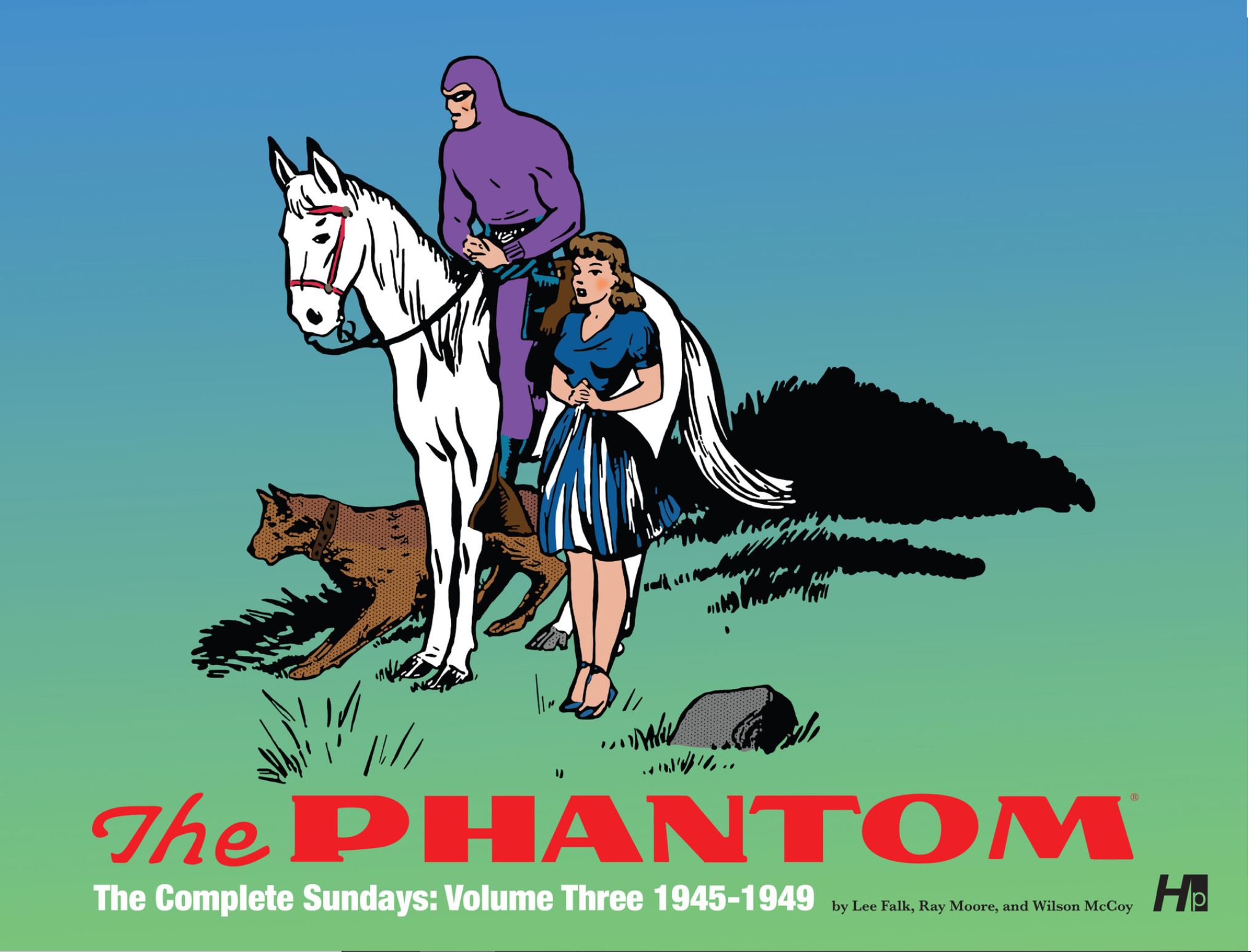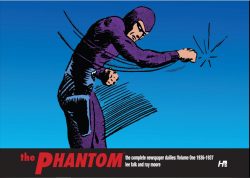
By Lee Falk, Ray Moore & Wilson McCoy: introduction by Daniel Herman (Hermes Press)
ISBN: 978-1-61345-100-7 (HB/Digital edition)
Born Leon Harrison Gross, Lee Falk created the Ghost Who Walks at the request of his King Features Syndicate employers who were already making history, public headway and loads of money with his first strip sensation Mandrake the Magician. Although technically not the first ever costumed champion in comics, The Phantom became the prototype paladin to wear a skin-tight body-stocking and the first to have a mask with opaque eye-slits…
The generational champion debuted on February 17th 1936, in an extended sequence pitting him against an ancient global confederation of pirates. Falk wrote and drew the daily strip for the first two weeks before handing over illustration to artist Ray Moore. The spectacular and hugely influential Sunday feature began in May 1939.
For such a long-lived, influential series, in terms of compendia or graphic collections, The Phantom has been quite poorly served in the English language market (except for the Antipodes, where he has always been accorded the status of a pop culture god). Many companies have sought to collect strips from one of the longest continually running adventure serials in publishing history, but in no systematic or chronological order and never with any sustained success. That began to be rectified when archival specialists Hermes Press launched their curated collections…
This third edition is a lovely and large (229 x 330 mm) landscape hardback/digital tome, displaying a complete full colour Sunday per page. Released in March 2016, its 208 pages are stuffed with sumptuous visual goodies like panel and logo close-ups, comics covers and lots of original art and opens with publisher Daniel Herman’s ‘Introduction: The Sunday’s Continue…’ recapping all you need to know about the feature and disclosing how Wilson McCoy assumed the illustrator’s role from Ray Moore – and why nobody knows exactly when he did…
For those who came in late: 400 years previously, a British mariner survived an attack by pirates, and – after washing ashore on the African coast – swore on the skull of his father’s murderer to dedicate his life and that of his descendants to destroying all pirates and criminals. The Phantom fights evil and injustice from his fabulous lair deep in the jungles of Bengali. Throughout Africa and Asia he is known as the “Ghost Who Walks”…
His unchanging appearance and unswerving war against injustice led to his being considered an immortal avenger by the uneducated, credulous and wicked. Down the decades, one heroic son after another has inherited the task, fought and died in an unbroken family line, with the latest wearer of the mask indistinguishable from the first and proudly continuing the never-ending battle.
In his first published exploit the Phantom met and fell for wealthy American adventurer Diane Palmer and his passion for her was soon reciprocated and returned and she became a continuing presence in both iterations of the series as ally, partner, sounding board, a means of reader identification and naturally a plot pawn and perennial hostage to fortune.
Almost every saga featured powerful, capable and remarkably attractive women as both heroes and villains, and in opening tale ‘Queen Pera the Perfect’ (running from December 9th 1945 to March 17th 1946), Diana saw the tables turned…
The aforementioned ruler of remote but rich Karola was constrained to find a husband, and so sent her fanatical minions into the world to find a man worthy of her. They returned with a musical genius, celebrated fighter pilot, champion pugilist and cinema’s greatest lover, but wherever they went they heard legends of an incredible superman…
After The Phantom repeatedly refuses her men’s offer, and gives her stern lesson in manners, she responds by having him imprisoned in her dungeons until he sees sense, and this time it’s his true love who has to save the day…
Spanning March 24th to August 4th 1946, ‘King of Beasts’ sees the liberated champion retuned to Bengali in time for Diana to be unjustly imprisoned. A priceless pearl necklace has been stolen from a maharajah and nobody believes the story of who actually took it: not the police and certainly not American mobster Poison Ivy and his boys…
When The Phantom tries to engineer a jailbreak, he’s caught too and charged with being an accomplice, only for the true thief to free him and Diana by sending a pickpocketing monkey to unlock their cell. In the ensuing flight, Diana is snatched by the mobsters, who don’t believe a word about a hidden mastermind using trained beasts to burgle. That all changes when a trained troop of elephants bust into the bank and porcupines empty a packed casino for their masked master…
With chaos unleashed, The Phantom retrenches and calls in his own equine ally and canine corps. Mighty steed Hero and lupine assistant Devil soon track down the King of Beasts who is far from what anyone expected. However even after he’s handled, there’s still increasingly murderous Poison Ivy to deal with…
Another female fury debuts in ‘The Scarlet Sorceress’ (August 11th – December 22nd) as a royal visit to the Deep Woods of the Bandar People introduces little Princess Valerie and her grandfather the Rajah of Volara. The child will soon become a pawn in a wicked plot…
When the princess of neighbouring kingdom Wogu falls ill, a devious manipulator “prophesies ” that only golden-haired Valerie’s blood can save the ailing waif, prompting a kidnapping and a frantically fast response from the Ghost Who Walks. Not all the monstrous forces set against him can slow the Phantom, but after exposing the witch as a charlatan, the hero discovers that he’s fighting not a villain but another victim. Soon, however, his efforts save all involved and pacify two kingdoms…
December 29th 1946 to June 29th 1947 finds The Phantom once more battling to save Diana after the filthy rich and spoiled Potentate of Ptjar Prince Pepe abducts her to be his very best bride. Law and reason mean nothing to the repulsive despot and by the time the hero reaches the distant kingdom, she is beyond even the Ghost’s reach. His only recourse is to play Pepe’s game and in a dozen days complete ‘The 12 Tasks’ conceived to frustrate and humiliate the hero. However, wit and ingenuity married to his mighty physicality make short work of the impossible – such as capturing an invulnerable giant bandit, emptying a river of carnivorous fish, banishing every shark in the bay or stopping all crime for 24 hours – and despite Pepe’s cheating equivocations the final task changes the nation forever and for the better…
A return to jungle warfare and tribal feuding underpins ‘The Dragon God’ (July 26th to November 16th) as Diana’s interest in an ancient Wambesi idol presages the fire-breathing saurian coming to life and demanding its worshippers kill and plunder their neighbours the Ulangi. With “The Phantom’s Peace” broken, the Ghost Walks amongst them to re-establish order and quickly discovers white instigators and recovered wartime weaponry behind the uprising, but once begun war has its own momentum and tribal grudges run deep and burn forever…
With bloodshed ended, a change of pace and tone heralds the return of an appalling duo who had previously made life miserable for The Phantom. Spanning November 23rd 1947 to May16th 1948, ‘The Marshall Sisters’ sees over-privileged brats Lana and Greta return to Africa in a ruthless no-holds barred competition to seduce and wed the mighty jungle avenger. This is after their last attempt to land the ultimate trophy husband was foiled by Diana Palmer…
When allure, deception and blackmail all fail, the hellions even try shanghaiing and blunt force trauma to achieve their aims, but lose all control when the various thugs they hire hijack the caper…
A relatively short story running from May 23rd through September 5th follows, revealing how a long-running annual sporting contest devised by the original ancestral Phantom has served to ameliorate tribal tensions for four centuries. Although its dollar value is meaningless to the competitors who strive for pride and bragging rights alone, the gem-stuffed urn that acts as ‘The Phantom Trophy’ is an irresistible prize for cop-killing fugitives Spike and Grunt.
When they rope in more scallywags to swipe the prize from the previous holders/custodians, before it can be handed over to the new champions tribal war erupts. Although The Phantom hunts the thieves he might be too late as naked greed turns the rogues against each other…
The final sequence in this volume visits ‘The Haunted Castle’ (September 12th 1948 – February 13th 1949) as Diana goes exploring alone and is propelled into wild unexplored country. As The Phantom and Devil search for her, she wanders a lost valley whose people are enslaved by sinister wizard Great Moogoo who shrinks anyone who opposes him to the size of a plaster gnome and adds them to his terrifying garden…
As the lascivious sorcerer captures her, Diana’s man has tracked her to the stone citadel and begun a one-man siege that exposes his nefarious trickery and wrecks his powerbase…
Taken from America’s immediate post-war period, these brief encounters are bold, brash, uncomplicated fare, full of despicable rogues, lost kingdoms, savage tribes, dangerous but still redeemable dames and very bad guys, but thrillingly reassuring entertainment for all that. Just remember, different times have different values. If the kind of fare you’d encounter in a 1940s Tarzan movie or cop thriller might offend, you should consider carefully before starting this…
Finally rediscovered, these lost treasures are especially rewarding as the material is still fresh, entertaining and addictively compelling. However, even if it were only of historical value (or just printed for Australians – manic devotees of the implacable champion from the get-go) surely the Ghost Who Walks is worthy of a little of your time?
The Phantom® © 1945-1949 and 2016 King Features Syndicate, Inc. ® Hearst Holdings, Inc. Reprinted with permission. All rights reserved.



